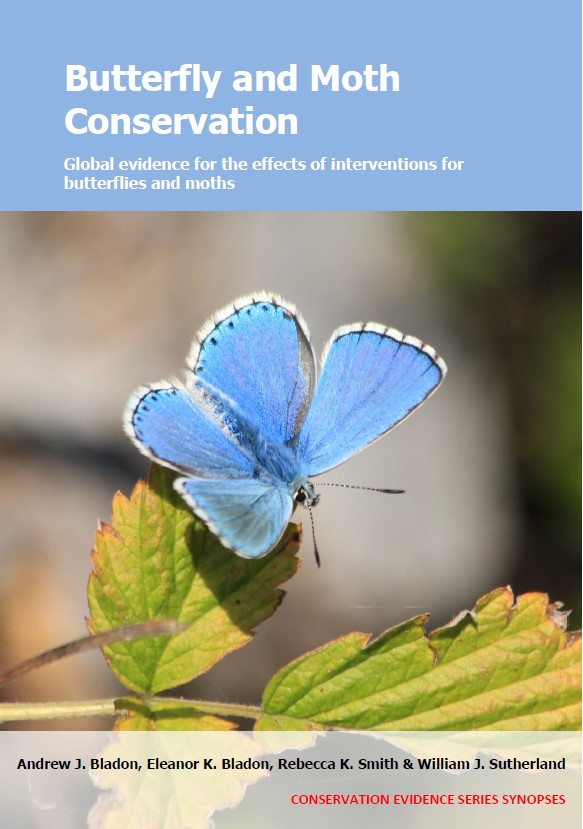Actions to conserve biodiversity
We have summarised evidence from the scientific literature about the effects of actions to conserve wildlife and ecosystems.
Review the evidence from the studies
Not sure what Actions are? Read a brief description.
Search for evidence
e.g. "frogs chytrid"
152 Actions found
Refine
Hide
152 Actions found
Download Actions
| 0 selected |
|
Order results by:
| Action | Effectiveness | Studies | Category | |
|---|---|---|---|---|
|
Alter mowing regimes on greenspaces and road verges Action Link |
Evidence not assessed | 7 |
|
|
|
Apply ecological compensation for developments Action Link |
Evidence not assessed | 2 |
|
|
|
Cease grazing on grassland to allow early succession Action Link |
Evidence not assessed | 26 |
|
|
|
Cease mowing on grassland to allow early succession Action Link |
Evidence not assessed | 16 |
|
|
|
Change mowing regime on grassland Action Link |
Awaiting assessment | 3 |
|
|
|
Change season/timing of prescribed burning Action Link |
Awaiting assessment | 2 |
|
|
|
Change turbine colour to reduce insect attraction Action Link |
No evidence found (no assessment) | 0 |
|
|
|
Change type of livestock grazing Action Link |
Awaiting assessment | 4 |
|
|
|
Clear or open patches in forests Action Link |
Evidence not assessed | 14 |
|
|
|
Convert to organic farming Action Link |
Evidence not assessed | 13 |
|
|
|
Coppice woodland Action Link |
Evidence not assessed | 10 |
|
|
|
Create beetle banks Action Link |
Awaiting assessment | 4 |
|
|
|
Create microclimate and microhabitat refuges Action Link |
No evidence found (no assessment) | 0 |
|
|
|
Create or retain deadwood in forest management Action Link |
Awaiting assessment | 1 |
|
|
|
Create scrapes and pools Action Link |
No evidence found (no assessment) | 0 |
|
|
|
Create uncultivated margins around intensive arable or pasture fields Action Link |
Evidence not assessed | 10 |
|
|
|
Create young plantations within mature woodland Action Link |
Awaiting assessment | 1 |
|
|
|
Delay cutting or first grazing date on grasslands to create variation in sward height Action Link |
Awaiting assessment | 7 |
|
|
|
Design the route of roads to maximize habitat block size Action Link |
No evidence found (no assessment) | 0 |
|
|
|
Employ areas of semi-natural habitat for rough grazing (includes salt marsh, lowland heath, bog, fen) Action Link |
Awaiting assessment | 9 |
|
|
|
Encourage natural regeneration in former plantations or logged forest Action Link |
Evidence not assessed | 4 |
|
|
|
Enhance natural habitat to improve landscape connectivity to allow for range shifts Action Link |
No evidence found (no assessment) | 0 |
|
|
|
Establish “green infrastructure” in urban areas Action Link |
Awaiting assessment | 1 |
|
|
|
Grow native trees within perennial crop plantations Action Link |
Awaiting assessment | 1 |
|
|
|
Harvest groups of trees or use thinning instead of clearcutting Action Link |
Awaiting assessment | 3 |
|
Download Actions
| 0 selected |
|

Butterfly and Moth Conservation - Published 2023
Butterfly and Moth Synopsis
Watch this search
If you are familiar with RSS feeds, please click the button below to retrieve the feed URL:
RSS feed for this searchIf you are unfamiliar with RSS feeds, we would suggest reading this BBC article.
Unfortunately, due to the number of feeds we have available, we cannot provide e-mail updates. However, you could use tools such as Feed My Inbox to do this for you.
What are 'Individual studies' and 'Actions'?
Individual studies
An individual study is a summary of a specific scientific study, usually taken from a scientific journal, but also from other resources such as reports. It tells you the background context, the action(s) taken and their consequences.
If you want more detail please look at the original reference.
Actions
Each action page focuses on a particular action you could take to benefit wildlife or ecosystems.
It contains brief (150-200 word) descriptions of relevant studies (context, action(s) taken and their consequences) and one or more key messages.
Key messages show the extent and main conclusions of the available evidence. Using links within key messages, you can look at the paragraphs describing each study to get more detail. Each paragraph allows you to assess the quality of the evidence and how relevant it is to your situation.
Where we found no evidence, we have been unable to assess whether or not an intervention is effective or has any harmful impacts.





)_2023.JPG)














